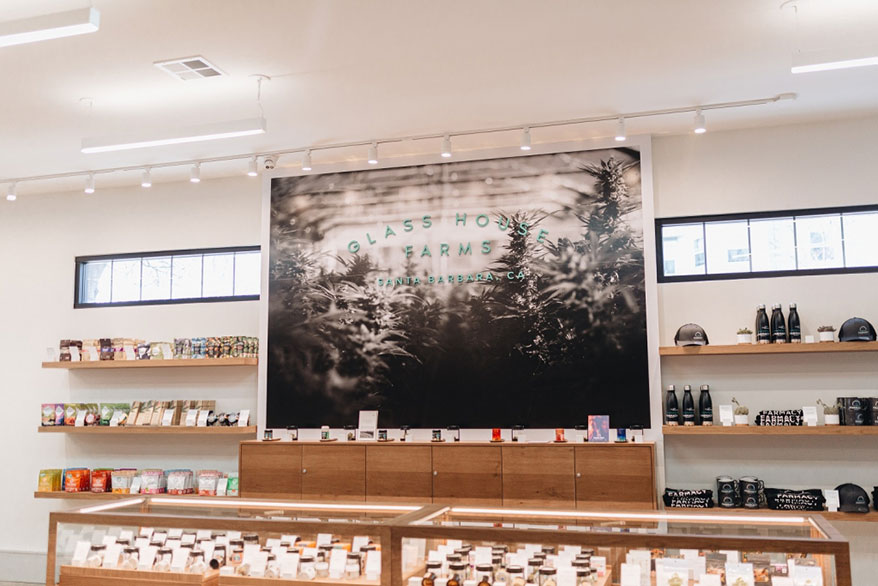Let’s start by exploring how the design of cannabis-related retail spaces is similar to traditional stores.
It depends. Right now, many cannabis retailers with deep roots in a medical market have functional, but very sterile environments. Often, it can almost feel like you are walking into a pharmacy rather than a traditional retail space.
Glass House Group has spent a lot of time figuring out how to bring the best 2.0 cannabis retail experience to customers. That involved looking at ways to improve overall flow and create a more intuitive layout for both customers and employees. Now, we approach our locations much like how a traditional retail space is laid out, including merchandising products by category, which makes it easier for our customers, particularly for the ones who are new to cannabis.

Jen Barry
OK, let’s flip that coin: How is it different?
Hands down, the biggest difference is in the first impression. In the cannabis space, when a customer approaches a retail location, they typically will see a security guard waiting for them at the front door, then walk into a reception area much like at a doctor’s office.
In traditional retail, the experience is much different. When you approach a retailer, there’s usually someone waiting to greet you, asking how they can help. In cannabis, due to regulatory requirements, that’s not possible. When the guest walks in, retailers must have the required reception, where customers’ identifications are checked.
Does Glass House Group use contract design firms to help create its stores? If so, what does it take to make the short list for such commissions?
Each of our four locations [all in California] have been designed independently. We don’t currently have one specific firm contracted for design. As we continue to grow, we would love to partner with one firm that understands the Glass House Group’s vision. Ideally, this would be someone who is in the mindset of looking through the consumer lens and offering a unique space that will keep the consumer coming back.
Advertisement
Sorry, but I have to ask: Did anyone ask if you were smoking something when you decided to go into the cannabis sector?
Actually, the reaction I got was the total opposite. With my background and accomplishments in women’s fashion and home retailing from the past 25 years, most people, including my mentors, family and friends, were not at all surprised by the industry shift.
When I started at Anthropologie we had 30 storefronts; when I left we had grown to 250. Traditional retail was changing, and the cannabis sector was heavily focusing on growing the retail space it sat in. People who know me know that I thrive in building the foundations and growing a business (excuse the pun on growing!).
You were a buyer at Nordy’s – tell us what lessons you learned from that time that are still with you today.
That was my first job in the retail space. In working there for 10 years, what I learned is to always look through the consumer’s lens. Every choice I make I say to myself, ‘How will the customer perceive this? How will they enjoy this? Does it add value or not?’ Another major takeaway was the importance of developing a solid team and giving them the infrastructure they need to grow and scale.
Same question for your time at Anthropologie:
I was there for 17 years, and a critical piece during that time was a heavy focus on relationship building. In my time at Anthro, I was successful because I put the time in with key partners to make sure they were strong. We were all aligned to the same goal and locked arms to achieve it and move forward. My time at Anthro also refined my communication skills and who I was, and am, as a leader.
Here’s more of our exclusive interview with Jen Barry, VP of Retail at cannabis seller Glass House Group, subject of the “Checking Out” column on page 36 of the July/August 2020 print edition of VMSD:
Advertisement
In addition to the entry experience, which you’d mentioned in the print part of this interview has a much heavier emphasis on security than traditional stores, in what other ways do the interiors of cannabis stores tend to be different?
In traditional retail, outside of high-end jewelry, products are not usually locked behind a case. In the cannabis space, due to regulatory requirements, our products are typically secured behind a glass counter, so that’s something that’s different.
The only interaction a customer can have with the product is a visual one. Consumers are used to a more tactile experience in traditional retail. Our job is to find ways to merge those experiences while still adhering to regulations.
GHG currently has four brick-and-mortar spots, all in California – two locations of The Farmacy (Santa Barbara and Berkeley); The Pottery (Los Angeles) and Bud and Bloom (Orange County). What are the company’s expansion plans?
We’re always looking into markets that we are not currently located in. I’ve had many conversations with the top executives at GHG about continuing to look in NorCal, as well as potentially tapping into San Diego. We are constantly exploring ways to align our branding so that we can get a higher return on investment on our marketing, brand representation and aesthetics. We are definitely not done growing and look forward to servicing more communities in the future.
In announcing your hiring at Glass House Group, CEO Kyle Kazan said one of your primary tasks will be to create a “3.0 retail experience for cannabis consumers.” What will that entail?
I have always said, ‘Let the customer have the journey that they want.’ Whether this means that the consumer wants to pop in and pick up their product with minimal interaction, or they want to come in and have a one-on-one moment with a budtender, it is ultimately their choice. The consumer has evolved, so in creating a 3.0 retail experience for cannabis consumers, we hope to meet their expectations, over and over again, while surprising them with moments they didn’t even know they wanted or needed.


 Photo Gallery1 week ago
Photo Gallery1 week ago
 Headlines3 days ago
Headlines3 days ago
 Headlines1 week ago
Headlines1 week ago
 Headlines1 week ago
Headlines1 week ago
 Headlines1 week ago
Headlines1 week ago
 Designer Dozen7 days ago
Designer Dozen7 days ago
 Headlines1 week ago
Headlines1 week ago
 Headlines1 week ago
Headlines1 week ago






















